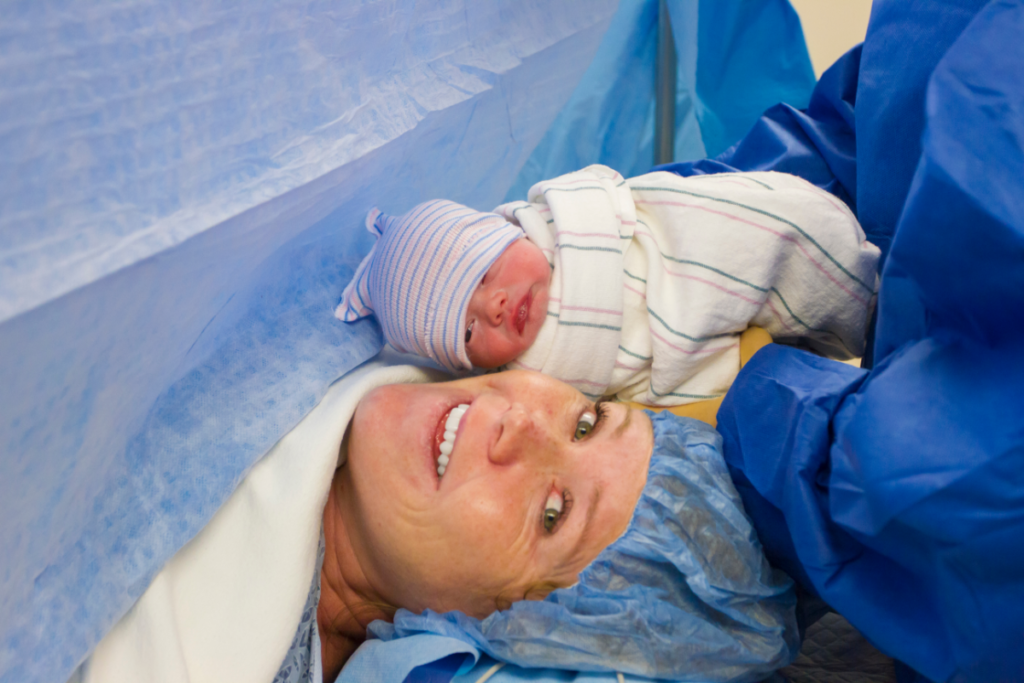
Introduction
Welcome to our guide on Cesarean Section, commonly known as C-section! This article explores when and why a C-section may be necessary and what to expect during this procedure. We’ll break down the information in a friendly and straightforward manner, ensuring everyone can easily grasp the essentials. Let’s embark on this journey of understanding C-sections together!
Table of contents
- Introduction
- II. When a C-Section is Needed
- III. The C-Section Procedure
- IV. Recovery and Postoperative Care
- V. Aspects of Emotion and Psychology
- VI. Vaginal Birth After Cesarean (VBAC)
- Conclusion
- Frequently Asked Questions (FAQs)
- How many layers are cut during a C-section?
- What are the side effects of a C-section delivery?
- What should I do the night before a C-section?
- Which is more painful, a C-section or natural birth?
- How many stitches are there in a C-section delivery?
- What are the side effects of a C-section years later?
- How long does an emergency C-section take?
- What is the most common reason for a C-section?
II. When a C-Section is Needed
Wondering why some pregnancies require a C-section? There are specific situations where this surgical procedure becomes essential for the health and safety of both the mom and the baby. Let’s take a friendly and easy-to-understand look at these circumstances:
A. Medical Necessity
- Failure to Progress in Labor: Sometimes, labor might not progress as expected, which could pose risks to the baby’s well-being or the mother’s health. In such cases, a C-section provides a safe and effective way to deliver the baby.
- Fetal Distress: If your healthcare provider detects signs of fetal distress during labor, like an irregular heartbeat or inadequate oxygen supply to the baby, a C-section may be recommended to ensure a quick and safe delivery.
- Placenta Previa: When the placenta partially or completely covers the cervix, it obstructs the baby’s exit during vaginal birth. In such cases, a C-section is often the safest option for both mother and baby.
- Breech Presentation: If the baby is positioned feet-first instead of head-first in the uterus, it’s called a breech presentation. Delivering a breech baby vaginally carries risks, making a C-section the preferred method.
- Multiple Pregnancy: In the case of twins, triplets, or more, a C-section may be necessary if certain complications arise during pregnancy or if the babies are not in optimal positions for a safe vaginal birth.
B. Maternal Indications
- Previous C-section: If a woman has had a C-section in a previous pregnancy, the risk of uterine rupture during a subsequent vaginal birth may be too high. In such instances, a C-section is often recommended.
- Chronic Medical Conditions: Women with certain pre-existing health conditions, like heart disease or high blood pressure, might be safer delivering via C-section to avoid potential complications during labor.
- Infections: In some cases, if a mother has certain infections, such as active genital herpes, a C-section might be suggested to prevent the transmission of the infection to the baby during vaginal delivery.
- Preterm Birth: When a baby is expected to be born prematurely, a C-section might be planned to ensure a controlled and safe delivery, especially if the baby’s lungs are not fully developed.
Understanding why and when a C-section is necessary can help dispel any concerns and uncertainties about this procedure. Remember, your healthcare provider will carefully assess your situation and recommend the best option for your and your baby’s well-being. In the next section, we’ll explore the C-section procedure, so you’ll know exactly what to expect on the big day!
III. The C-Section Procedure
You’re expecting, and the big day is approaching! Let’s take a friendly and easy-to-understand journey through the C-section procedure so you know exactly what to expect on this special day:
A. Preoperative Preparations
- Consent and Paperwork: Before the C-section, your healthcare team will explain the procedure and obtain informed consent. Don’t worry; they’ll be there to answer any questions!
- Fasting and Medications: You’ll likely be asked not to eat or drink anything for a specific period before the surgery. Your healthcare provider will also guide you on any medications you need to take or avoid.
- Anesthesia Options: Most C-sections are performed with regional anesthesia, like an epidural or spinal block, which numbs the lower part of your body but keeps you awake during birth. However, general anaesthesia may be required in some circumstances.
B. Operating Room Setup
- Sterility Measures: The operating room will be a clean and sterile environment to minimize the risk of infection. Your healthcare team will ensure everything is in place to keep you safe.
- Support Team: During the C-section, you’ll be in capable hands! Your support team will include a skilled surgeon, anesthesiologist, nurses, and other medical professionals.

C. Incision Types
- Traditional Horizontal Incision: The most common incision for a C-section is made horizontally just above the pubic hairline. This incision allows for safe and controlled delivery of your baby.
- Low Transverse Incision (Bikini Cut): In some cases, a low transverse incision might be used, similar to a bikini line cut. This type of incision usually heals well and leaves a less noticeable scar.
D. The Surgery Process
- Anesthesia Administration: Once in the operating room, you’ll receive numbing medication through a small needle in your back if you’re having regional anesthesia. This ensures you won’t feel pain during the procedure.
- Incision and Access to the Uterus: After the anesthesia takes effect, the surgeon will make the incision in your abdomen to reach the uterus safely.
- Delivery of the Baby: With the uterus exposed, the surgeon will gently deliver your baby through the incision. You might feel some pressure, but there shouldn’t be any pain.
- Placenta Removal: The medical team will carefully remove the placenta from your uterus after your baby is born.
E. Potential Complications and Risks
- Infection: Though rare, like any surgery, a C-section carries a small risk of infection. Your healthcare team will take all necessary precautions to prevent this.
- Blood Loss: During the procedure, you might experience some blood loss. Don’t worry; the medical team will monitor and manage it carefully.
- Injury to Organs: In rare cases, organs like the bladder or bowel may sustain minor injuries during the procedure. Your surgeon will be diligent in preventing any such complications.
- Anesthesia-related Risks: Anesthesia is generally safe but can have some side effects. Your anesthesiologist will closely monitor you to ensure your safety throughout the procedure.
A thorough understanding of the C-section procedure will help you feel less anxious. Your health and the health of your child are considered in every decision that is made. In the next section, we’ll go into detail about the immediate postoperative treatment and what to anticipate during your recovery. Together, let’s keep going forward!

IV. Recovery and Postoperative Care
Congratulations, you’ve welcomed your precious bundle of joy into the world through a C-section! Let’s explore what happens next and what to expect during your recovery. We’ll guide you through this phase in a friendly and easy-to-understand way:
A. Immediate Post-Op Care
- Monitoring Vital Signs: After the C-section, you’ll be moved to a recovery area where the medical team will closely monitor your vital signs, such as heart rate, blood pressure, and breathing, to ensure everything is stable.
- Pain Management: It’s normal to experience some discomfort after the surgery. Your healthcare team will provide appropriate pain medications to keep you comfortable.
- Early Mobility: Getting up and moving around as soon as possible after the procedure is encouraged. It helps with blood circulation and can aid in your recovery.
B. Hospital Stay Duration
- Typical Length of Stay: Your hospital stays after a C-section can vary. It’s generally around 2 to 4 days, depending on your situation and how well you and your baby are doing.
- Signs of Complications: Your healthcare team will be on the lookout for any signs of complications, such as infection or excessive bleeding, and take prompt action if needed.
C. Incision Care and Scar Healing
- Keeping it Clean: Your incision will be closed with stitches or staples, and keeping it clean and dry is crucial to prevent infection. Your healthcare team will provide instructions on how to care for it.
- Scar Healing: The incision will heal over time and form a scar. It’s essential to be patient, as scars take time to fade. Protecting the area from direct sunlight can also help reduce discoloration.
D. Breastfeeding After a C-Section
- You can still breastfeed! Rest assured, having a C-section doesn’t mean you can’t breastfeed your baby. You can start breastfeeding as soon as you feel comfortable.
- Find a comfortable position: Experiment with different breastfeeding positions to find what works best for you and your baby, considering your incision site’s comfort.
E. Managing Pain and Discomfort
- Take it easy: Avoid heavy lifting and strenuous activities during the initial weeks of recovery. Focus on resting and caring for your baby.
- Pain relief options: Your healthcare provider might recommend over-the-counter pain medications or prescribe something stronger. Always follow their guidance.
F. Resuming Normal Activities
- Physical Activity and Exercise: Gradually ease back into your regular physical activities, starting with light exercises like walking, as approved by your healthcare provider.
- Driving and Lifting Restrictions: Following your healthcare provider’s advice on when it’s safe to resume driving and lifting heavy objects is crucial.
Everybody’s road to recovery is different, so have compassion for yourself. Be supported by your family and friends, and don’t be afraid to contact your medical team if you have any worries or inquiries. Your baby’s health and well-being are our top priorities, as well as yours!
The emotional and psychological effects of having a C-section will be discussed in part after, along with how to deal with any possible feelings. Together, let’s continue on this great parenting journey!
V. Aspects of Emotion and Psychology
Greetings on being a parent for the first time! A rush of emotions can accompany welcoming your child into the world through a C-section. It’s crucial to treat the psychological and emotional effects of this encounter with compassion:
A. Dealing with the Experience of the C-Section
- Mixed Emotions: A range of feelings following a C-section is normal. While some parents might be happy that their child is safe, others could be unhappy that a vaginal birth was impossible. There is no one appropriate way to feel; all emotions are legitimate.
- Talking it Out: Don’t be afraid to express your thoughts to your spouse, close friends, or family. Sharing your ideas and worries with someone else may be immensely reassuring and aid your emotional processing.
B. Addressing Feelings of Disappointment or Failure
- Letting Go of Expectations: It’s acceptable to be upset if your birth plan didn’t turn out as you had hoped. Give yourself time to work through these feelings while keeping in mind that your own and your unborn child’s health and well-being are what matter.
- Celebrate Your Strength: Your strength as a parent is unaffected by having a C-section. Regardless of the mode of birth, you have created a lovely life, which is an amazing accomplishment.
C. Bonding with the Baby After a C-Section
- Skin-to-Skin Contact: C-section mothers can still have close physical contact with their newborns. Both you and your child will benefit from this close-knit bonding time.
- Connection via Breastfeeding: Breastfeeding is a fantastic method to strengthen your relationship with your child. Be bold and ask lactation experts or your healthcare practitioner for advice and assistance if you encounter any problems.

D. Seeking Support and Help
- Reach Out: If you’re experiencing stress or emotional difficulty, don’t be afraid to ask for professional support or speak with a counselor. Keep in mind that you don’t have to experience this alone.
- Making Friends with Other Parents: Friends with other parents who have had C-sections can be made by joining local or online support groups. It may be immensely beneficial and encouraging to share stories and advice.
E. Patience and Self-Compassion
- Be patient: both a bodily and an emotional recovery takes time. Be kind to yourself and give yourself space to recover at your rate.
- Self-compassion: Be nice and compassionate to yourself as you would a close friend. You’re doing a fantastic job; what counts most is how much you love your child.
Remember that motherhood is a journey with ups and downs, so taking things slowly is appropriate. Remember your special times with your child, and enjoy being a parent. Your infant is fortunate to have you as a parent, and you’re doing a fantastic job!
We’ll discuss vaginal birth after cesarean (VBAC) and the opportunities it presents for subsequent pregnancies in part after that. Let’s continue this journey of knowledge together!
VI. Vaginal Birth After Cesarean (VBAC)
You might be interested in vaginal birth after cesarean or VBAC if you’ve had a C-section in the past and are thinking about having a vaginal birth in subsequent pregnancies. Let’s examine this choice in an approachable and clear manner:
A. What is VBAC?
Vaginal Birth After Caesarean, or VBAC, is the term used to describe having a baby vaginally after a prior C-section.
Is VBAC safe? VBAC is a safe and effective choice for many women. However, the choice to have a VBAC is personal and influenced by several variables.
B. Eligibility and Safety Considerations
Your healthcare professional will carefully review your medical history and the circumstances surrounding your last C-section to decide whether or not a VBAC is an option for you.
The type of uterine scar left over from your last C-section affects whether or not a VBAC is safe. Certain uterine scars lend themselves more readily to vaginal delivery than others.
C. Benefits and Risks of VBAC
Benefits of VBAC: Compared to a repeat C-section, VBAC may offer a quicker recovery period. Additionally, it prevents the hazards connected with repeated C-sections, such as probable side effects from abdominal surgery.
VBAC risks: Although largely risk-free, there is a very tiny chance of uterine rupture, which occurs when the scar from the prior C-section ruptures during labor. The danger is minor and closely managed, though.
D. Preparing for a VBAC
Prenatal Care: According to your doctor’s advice, attending routine prenatal checkups is crucial for a successful VBAC.
Birth Plan: Talk to your healthcare practitioner about your intention for a VBAC. You should develop a birth plan that supports your objectives and safeguards your safety.
E. VBAC Success and Birth Choices
VBAC Success Rate: Most women who try VBAC succeed and give birth vaginally. Though delivery might be unpredictable, remember that it’s still possible that you’ll need a C-section during labor.
Alternative Birth Options: The most crucial factor is a safe birth for you and your child, whether you choose a repeat C-section or VBAC. Your healthcare professional will assist you in making the right choice.
Keep in mind that vaginal delivery is a possibility with the VBAC option. The most important factor is your lovely child’s safe arrival, regardless of the delivery technique. Trust the advice of your healthcare practitioner and choose what seems best for you and your family.
Conclusion
In conclusion, every woman has a different experience throughout pregnancy and labor. We hope this article has given you useful knowledge on C-sections, VBAC, and what to anticipate during the procedure. The most crucial thing is to be knowledgeable, make educated decisions, and appreciate the amazing experience of parenthood. Wishing you a safe and joyful birth experience!
Also Read: Labor and Delivery: What to Expect During Each Stage
Frequently Asked Questions (FAQs)
How many layers are cut during a C-section?
During a C-section, typically, three layers are cut: the skin, the underlying fatty tissue, and the uterus. Each layer is carefully sutured after the baby is delivered to promote healing.
What are the side effects of a C-section delivery?
C-sections are generally safe, but like any surgery, they can have side effects such as pain, bleeding, and infection. Your healthcare provider will closely monitor you and provide appropriate care to manage any side effects.
What should I do the night before a C-section?
The night before your scheduled C-section, follow your healthcare provider’s instructions regarding fasting and any specific preparations. Be sure to get plenty of rest and mentally prepare for the upcoming procedure.
Which is more painful, a C-section or natural birth?
Pain experiences can vary for each person, but it’s common for C-sections to involve more postoperative pain compared to vaginal births. However, pain management techniques can help minimize discomfort during recovery.
How many stitches are there in a C-section delivery?
The number of stitches or staples used to close the incision after a C-section varies, but it’s typically between 2 to 3 layers of sutures. Dissolvable stitches are often used on the inside, while the outer layer may require removal after a week or two.
What are the side effects of a C-section years later?
Years after a C-section, some women may experience scar discomfort or sensitivity. In rare cases, there might be an increased risk of developing certain complications during future pregnancies, which your healthcare provider can monitor.
How long does an emergency C-section take?
In an emergency C-section, the procedure is performed swiftly to ensure the safety of the baby and the mother. The actual surgery duration can vary depending on the circumstances, but it is typically completed within 45 minutes to an hour.
What is the most common reason for a C-section?
The most common reasons for a C-section include failure to progress in labor, fetal distress, breech presentation, and previous C-section history. Your healthcare provider will recommend a C-section if it is necessary for you and your baby’s well-being.


